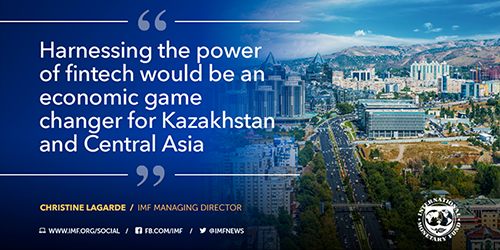Finding a Path to the Higher Plain of Inclusive Growth
May 16, 2019
As prepared for delivery
Introduction
Salem! Good morning.
Thank you, Yel’bassy Nazarbayev, for welcoming me to this year’s forum.
As I arrived in Nur-Sultan yesterday, I thought about the last time I visited Kazakhstan. On that trip, so many people shared with me the words of the famous poet, Abai. One of his phrases has stuck with me over the years: “While walking slowly, stride confidently.”
So, today, I would like to borrow this idea as we discuss the outlook and the challenges for the region.
I. The Outlook: Global and Regional
We are gathered at a delicate moment for the global economy.
Two years ago, 75 percent of the global economy experienced an upswing. This year, we expect 70 percent to experience a slowdown in growth. 1
The loss of global growth momentum in the second half of 2018 reflected in large part trade tensions and tightening financial conditions. Yet, over the next six months, we expect the global economy to rebound. So, you can see what I mean by a delicate moment.
The next steps we take together will be critical in putting us on the right path. This region will play a key role.
Throughout the Caucasus and Central Asia (CCA), growth has picked up since 2014 and is now expected to remain at 4.1 percent this year and in 2020. However, this number is still well below the long-term potential for the region — and it is too low if the region is to raise living standards to the level of other emerging economies in Europe and Asia.
So, the challenge is clear. We need to elevate growth to a higher plain. We need to stride carefully, yet confidently on this path. We need good domestic policies, increased economic diversification, and stronger international cooperation.
Most importantly, we need inclusive and sustainable growth that lifts up the prospects of women, young people, the poor, and those who live in rural areas, and that raises the expectations of future generations.
New IMF research, released today, focuses on achieving precisely this kind of inclusive growth in the region. Allow me to briefly highlight the path we see.
II. The Path to Inclusive Growth
There is no “one-size-fits-all” solution, but a few principles are clear.
- First, fiscal policy should balance debt concerns with critical initiatives in health, education, and infrastructure. Here, the IMF will continue to support the region through technical assistance and capacity development programs.
- Second, corruption needs to be addressed head-on in the region. 2019 is an opportune moment to provide increased transparency and foster more trust between citizens and the government.
- Third, women and other under-represented groups can be empowered by continuing to eliminate legal and economic barriers. I am pleased to say that through the hard work of the government and private companies female labor force participation in Kazakhstan is now at 65%2 — the highest in the region and a benchmark for every country in Central Asia.
- Fourth and finally, the financial sector should be sound and its services widely accessible. Just 45 percent of adults in CCA countries have a banking account — almost 20 percent lower than the average in other emerging markets. Furthermore, only 3 percent of citizens have mobile money accounts3 .
These numbers reveal an incredible untapped resource for the region. And a resource that is environmentally sustainable and that can procure diversification from oil and gas as the predominant sources of growth!
If Central Asia can harness the power of fintech, as emerging economies in other regions have done, the potential gains for the poor, women, and young people are significant. 4
Each of these principles is part of the toolkit the region needs in order to reach a higher plain of inclusive growth. And while this morning my focus is on more inclusion within countries, today’s forum is also a chance to build more connections between countries.
In 2018, in Central Asia, less than 10 percent of trade was conducted between countries in the region. In the European Union, the number is over 60 percent.
The landscape, however, is beginning to shift. In just the past year there has been a surge of trade on the Kazakhstan-Uzbekistan border. New regional opportunities in the form of roads, railways, and electricity grids are finally coming online. And last month, a “Silk Visa” plan was announced to allow for easier travel between the nations of Central Asia.
These initiatives can rebuild the Silk Road connections that once helped this part of the world become a hub for global trade and learning. And they can play a role in each country’s journey to achieve more diversified, sustainable, and inclusive growth.
Conclusion
Let me conclude. I believe inclusive growth is well within the reach of this nation and all countries in the region. We can actually draw inspiration from our surroundings.
You may be asking yourself, “We are in the steppes, in the flatlands, what inspiration can our surrounding provide about higher growth?” Well, quite a bit.
Think of the famous proverb: “Kazakh hearts are like the steppes—wide, kind, and generous.”
If we all embrace that spirit, we can generate economic growth, raise living standards, and provide new chances for millions.
That will indeed be a higher plain.
Thank you very much. Rakhmet.
1 April 2019 World Economic Outlook, Chapter I.
2 IMF Departmental Paper. Promoting Inclusive Growth in the Caucuses and Central Asia. May 2019.
3 Id.
4 Id.
5 IMF departmental Paper. Opening Up in the Caucasus and Central Asia. February 2019.









